Project Updates
December, 2017
We conducted another urine collection trial with sheep fitted with sensors from Swansea University, in order to relate the duration of the sheep’s crouch time to urine volume. The data will be used in order to predict the amount of sheep urine deposited to the uplands and will be important for wider prediction of N2O emissions form the uplands.
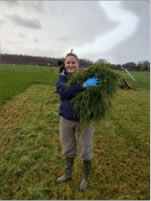
Karina Marsden, cutting and carrying feed for sheep.
November, 2017
We took 100 soil cores from the heft (common grazing land for Bangor University’s sheep flock) in order to understand the spatial variability in soil properties and N2O emissions. The data will feed into the modelling component of the project in order to predict N2O emissions from grazing in the uplands on a wider scale.
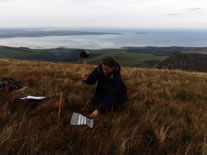
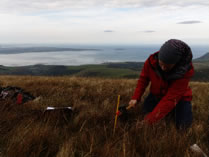
Karina Marsden (left) and Rob Brown (right), taking soil cores from 100 different locations across the common grazing land, which Bangor University’s sheep flock graze.
Alice Charteris, Laura Cardenas and Dave Chadwick attended the Sustainable Intensification Conference hosted at Rothamsted Research, Harpenden. The conference explored the outcomes of the £4 million Department for Environment Food and Rural Affairs (DEFRA) funded Sustainable Intensification Research Platform (SIP), amongst other contributions. A poster presentation of the preliminary results of the DENIS experiments for the semi-improved site was given.

Laura Cardenas presenting some results from the NW Farm Platform at the Sustainable Intensification conference.
October, 2017
The autumn field trial was set up and is now underway, monitoring greenhouse gas emissions from sheep urine collected from and applied to the unimproved, common grazing land, within Snowdonia National park.


Sheep in urine collection pens (left) and Danielle Hunt, helping to set up the automated greenhouse gas monitoring system (right)
Final year BSc Geography student Emily Cooledge, conducted a work placement with the Uplands-N2O project over summer. She has now started working on her dissertation project, in-line with the Uplands-N2Oproject, supervised by Prof. Dave Chadwick and Dr Karina Marsden. In this study, artificial sheep urine was applied to peat and acid grassland soil cores, where greenhouse gas samples and soil solution samples were taken to measure the soil nitrogen transformations. This study will contribute to understanding the importance of spatial differences in soils / vegetation types for urine-patch N2O emissions from the uplands.


Measuring soil depth of the peat and acid grassland ‘islands’ (left). Exploring the spatial differences in acid grassland ‘islands’ and peat soils of the Uplands-N2O field site, within Snowdonia National Park (right).


Artificial sheep urine applied to acid grassland (left) and peat (right) soil cores.

Snow at the Uplands-N2O filed site during collection of soils for microbiological analyses.
September, 2017
We deployed the final 30 sheep fitted with sensors and GPS for the project. The last two deployments (June and Sept, 2017) were on the common grazing land, within Snowdonia National Park, where the sheep could roam freely in a much larger area. Data have been successfully downloaded and is currently being processed to identify sheep urination events during the tagged period. This can then be compared to the data from the previous deployments in the enclosed uplands and used for further spatial modelling with other project data.

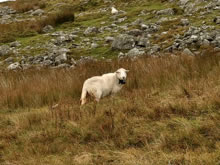
Sheep fitted with GPS collar (left) and grazing in Snowdonia National Park (right).
The autumn Uplands-N2O project meeting was hosted at Rothamsted Research, North Wyke. It was fantastic catching up and hearing all the updates from the team. There are so many possibilities for using all the data we have been collecting, but also still a lot of work to do! Highlights included meeting our new post-doc colleague working in Leicester, Sarah Johnson and the PhD and master’s students working on Uplands-N2O related projects (Ma Yan, Harry Barrat, Danielle Hunt and Emma Tucny).
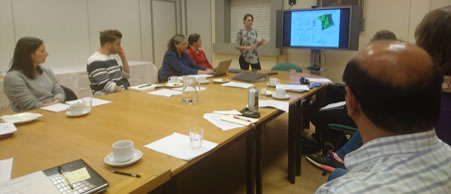
Karina Marsden presenting some results from the spatial N2O sampling campaign.

Emma Tucny presenting the results of her investigation of the social behaviour of sheep using the sheep tag data.
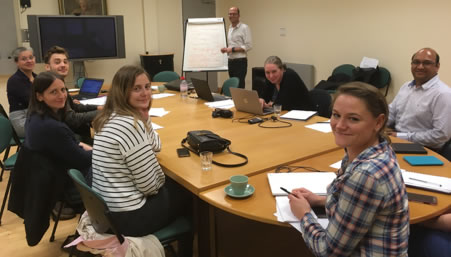
Dave Chadwick facilitating the brainstorming session on how best we should use and present all the data we have been collecting.

Team photo outside the North Wyke Manor House: (from left) Sarah Johnson, Harry Barrat, Emma Tucny, Lucy Lush, Dave Chadwick, Karina Marsden, Danielle Hunt, Alice Charteris, Ma Yan, Laura Cardenas and Sreenivas Ravella.
June, 2017
The mobile greenhouse gas laboratory was taken up to the common grazing land, within Snowdonia National Park. The field trial was set up to quantify nitrous oxide emissions from sheep urine applied to these acidic, peat soils, in spring.

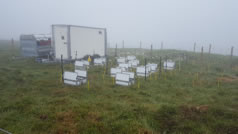
Moving the greenhouse gas laboratory to the upland field site and setting up the experiment ready for application of sheep urine.
At Rothamsted Research, North Wyke, the semi-improved site laboratory experiments were carried out using the state-of-the-art Denitrification Incubation System (DENIS). The DENIS allows small soil cores to be sealed in steel vessels and incubated under a controlled (e.g. nitrogen gas-free) atmosphere, so it enables any nitrogen production by denitrification to be measured. Four two-week incubation experiments were conducted in quick succession with the assistance of a visiting PhD student, Antonio Castellano-Hinojosa, testing the combined influence of five factors affecting urine-derived N2O emissions (soil type, moisture and temperature and sheep urine volume and nitrogen concentration) at different levels (e.g. dry, medium and wet soil, high and low sheep urine nitrogen concentrations…). In total 48 different combinations were tested and the resulting N2O emissions recorded. Data analysis to assess which combinations gave the highest and lowest N2O emissions is ongoing.
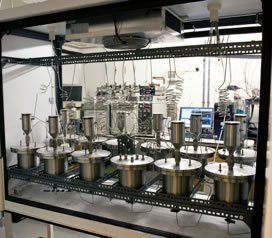
DENIS vessels with recording instruments in the background.
April, 2017
Alice Charteris attended EGU 2017 in Vienna and presented a poster on the non-hierarchical sampling method used to collect a representative soil sample from the semi-improved site for the laboratory incubation experiments and the fractional factorial experiment design selected to efficiently provide information on how the factors affecting urine-derived N2O emissions interact.

Alice Charteris presenting her poster at EGU, 2017.
A stable isotope laboratory incubation experiment was set up in order to understand the fate of sheep urine nitrogen after application to soil cores taken from the enclosed hill land.
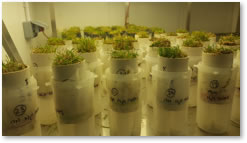
Intact soil cores taken from enclosed hill land (240-340 m above sea level).
February 2017
The team at Swansea University hosted an Uplands-N2O project meeting, enabling all team members to get together and discuss the progression of the different strands of the project. A highlight of the meeting was a visit to the data visualisation lab, to see the sheep tag data.


The Uplands-N2O team (left) and visualisation of the sheep GPS data (right) at Swansea University.
